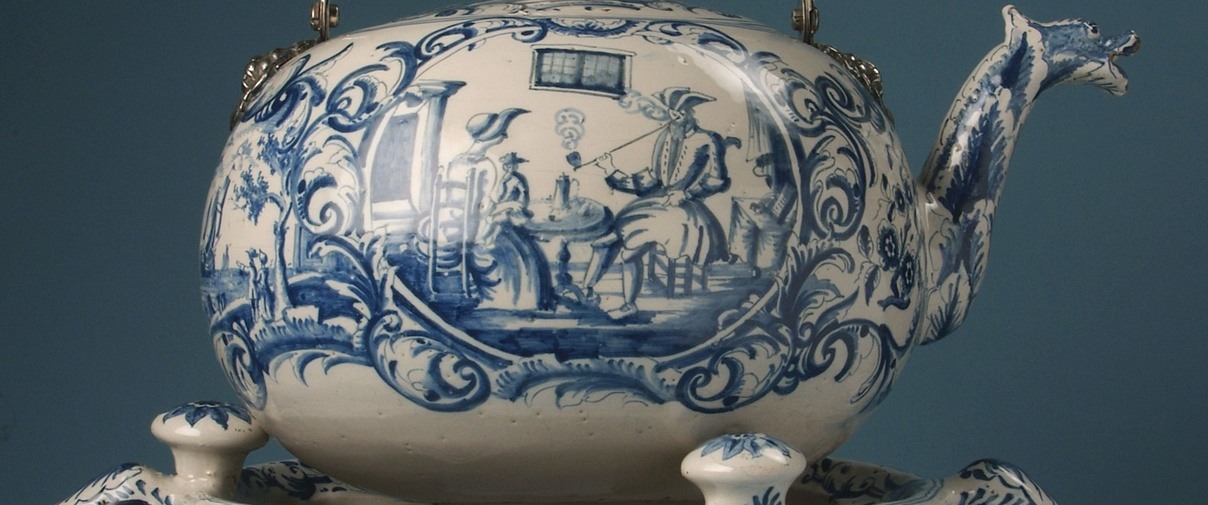Kettle on warmer, Glei Bakery Tichelaar in Makkum, approx. 1772, porcelain, kettle: h. 16 cm and 14 cm, warmer: h. 14 cm and 24 cm, on loan from Ottema-Kingma Foundation.
This kettle with matching warmer is considered a highpoint in Frisian earthenware. It was made at the Tichelaar earthenware and tile factory in Makkum by the head of the workshop, Gatse Sytses (Makkum, approx. 1724 - 1798). Sytses was a prolific painter, and much of his work is documented. He dated both pieces with the year 1772. Among other things, the set is adorned with cartouches, elegant frames containing domestic scenes of a couple drinking tea or coffee. The figures are dressed according to the fashion of the time. The ladies wear a ‘Dutch’ cap and the men a tricorne. One of the cartouches on the kettle depicts a seascape with ships. The cover has a decoration of a fisherman and a man with a dog: commonplace scenes in eighteenth-century Makkum. Curiously enough, a kettle on a warmer is depicted on the floor in one of the interior scenes. The Droste effect avant la lettre!
Many characteristics of Frisian tin glaze earthenware can be distinguished on the kettle. The somewhat heavy, contrasting way of working with the blue and the frequent use of flowers and stylised acanthus leaves are typical. The somewhat plump shape of the strainer and the shape of the handles also indicate a Frisian origin. These refer back to specimens that were made in lead glaze, which is transparent, as opposed to the white, opaque tin glaze. The round shape of the kettle is of particular note. It bears a striking resemblance to silver examples, such as a kettle by Johannes Laases Spannenburg (Harlingen, 1759). The kettle made by the Leeuwarden silversmith Regnerus Elgersma in 1767 has the same shape. The spout ends in the head of a fabulous animal. Such spouts, including their floral decoration, were in vogue on silver cauldrons during the first half of the eighteenth century. Here it is imitated in earthenware.
It is quite possible that the kettle initially had an earthenware handle, which was later replaced by this silver version with lion masks. Ceramic handles were very fragile. The silver does not bear any marks or dates. It may have been added in the nineteenth century, but could also date from 1772.
Earthenware
The clay in Northwest Friesland is very suitable for making earthenware and tiles. As early as the beginning of the seventeenth century, majolica – earthenware with tin glaze on the front and lead glaze on the reverse – was made in Harlingen. Makkum followed in 1700, and there was also a glazing factory (the Frisian variant of the Delftware factory) in Bolsward. These companies produced millions of tiles and tens of thousands of dishes. The highpoint of this industry was in the eighteenth century. In addition to simple consumer earthenware, manufacturers, and hence painters, also concentrated on the production of ornamental earthenware. Talented painters developed their own style, giving Frisian earthenware its unique character. Gatse Sytses, who made this kettle and warmer in 1772, was one of the best.
Hugo P. ter Avest, director of the Hannemahuis, Centre for Harlinger Culture and History.
